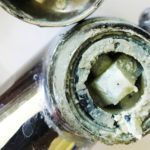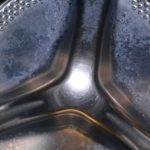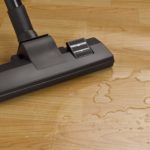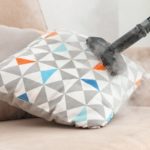Anyone who lives in a hard water area will be familiar with the unsightly white marks that build up on bathroom and kitchen surfaces.
Hard water is water that contains a high concentration of minerals, mainly calcium and magnesium carbonates, picked up from chalk or soft rocks including limestone.
Unlike ‘soft water,’ which as relatively low mineral concentration, hard water leaves behind a mineral residue once evaporated.
Commonly called limescale, this white substance is composed of minerals that can gradually harden onto any household surfaces and fixtures that are regularly exposed to water. Not only is this unattractive, but it can actually clog up your appliances, shortening their useful lives.
Limescale is notorious for its stubborn nature which is can be tricky to remove. Luckily, there are a range of specialist products on the market that specifically target this stubborn substance.
Best Bathroom Cleaners for Limescale
1. HG Professional Limescale Remover
Bottle size: 1000 ml
HG Professional Limescale Remover is a super concentrated formulation for use on severe limescale and calcium build-up. Suitable for use on bathroom surfaces, this is a good product for specialised jobs, such as descaling the shower head or taps.
It’s also designed to remove a variety of other unsightly substances including rust, stains, verdigris (the greenish oxidisation on metals such as copper) and general dirt.
This cleaner can be applied neat or diluted in water, according to the amount of limescale buildup; just be aware that this is a highly concentrated cleaner and you should always protect your skin with gloves during use.
2. HG Shower and Washbasin Spray
Bottle size: 500 ml
If the HG Professional spray seems a little too heavy-duty for your house, try HG Shower and Washbasin Spray.
This is the everyday version of the concentrated formula and is well suited to lighter jobs. It’s designed to clean up mild limescale deposits as well as other bathroom grime like soap scum.
One of the best features of this cleaner is that it can be applied to any household surface. While this has been specifically designed as bathroom spray, it won’t cause any harm to acid-sensitive materials such as granite and marble.
Unlike many commercial limescale removers, this product is safe to use anywhere in the home, though proper safety precautions should always be taken.
3. Viakal Limescale Remover Spray
Bottle size: 500 ml
Available both in a spray bottle and a refill container, Viakal Limescale Remover Spray claims not only to remove limescale residue, but to actually prevent watermarks from coming back in the future.
The spray is said to leave a protective film that prevents new build up, even after you’ve wiped the product away.
In order to keep the preventative film in place, regular application is necessary, making this a good option for people who don’t mind doing a little bit of housekeeping every day.
While suitable for use on glass, ceramic and chrome surfaces, this acid-based formula shouldn’t be used on natural stone, household appliances or some metals including silver, copper and gold.
4. Cillit Bang Limescale and Shine Power Cleaner
Bottle size: 750 ml
As its name suggests, the Cillit Bang Limescale and Shine Power Cleaner packs a punch against limescale. This powerful formula uses a “Turbo Foam” action to get rid of tough stains including limescale, soap scum, dirt and rust. Just spray, leave to sit for five minutes and wipe away.
Since the Power Cleaner is a powerful product, this also means that it’s a harsh one. It comes with a litany of safety warnings, so if you’re going to choose this formula, make sure to follow the safety precautions such as wearing skin and eye protection.
This product is too harsh for several surfaces including natural stone, metals, rubber, treated wood and linoleum. It can also be corrosive to metals, so this product is best used on your bathroom enamelware or glass.
5. White Vinegar
Bottle size: 5 litres
For people who prefer to go natural, white vinegar is a cheap, eco-friendly cleaning alternative for getting rid of limescale. While usually used in cooking, vinegar has hundreds of uses as a household cleaner.
The acetic acid in vinegar dissolves the minerals in limescale, making it easy to remove without the need for scrubbing.
To descale with vinegar, it may be necessary to soak the relevant area for a few minutes to an hour in order to fully dissolve the buildup.
You may also need to repeat the process to completely remove the limescale, but the effort involved is minimal, since the minerals just melt off your surfaces.
To clean fixtures like taps and showerheads, soak a cloth in vinegar and wrap it around the affected area (fasten it in place with a rubber band if needed), then leave it to sit for as long as you think is necessary.
Glass surfaces can be cleaned by pouring some vinegar into a spray bottle and using it as you would use a commercial cleaner.
The great thing about using vinegar rather than commercial cleaning products, is that it’s non-toxic and can be safetly used to clean kitchen equipment such as the kettle or dishwasher.
To remove limescale from the kettle, simple pour in enough vinegar to cover the affected areas and let it soak for an hour or so, before pouring it out and gently scrubbing out the mineral residue.
Machines including the dishwasher or washing machine can be cleaned by pouring some vinegar into the detergent box and running the machine on an empty cycle.
If you don’t happen to have any vinegar, or if you just don’t the smell, other acidic substances also work, with lemon or lime juice being good alternatives.
Viakal vs Cillit Bang – Which Is Best for Limescale?
Since both Viakal and Cillit Bang are marketed as being excellent for tackling limescale, you may find yourself wondering which is best for your uses.
All-round use
If you are just looking for a way to remove limescale across a multitude of surfaces and do not want to have to store multiple chemicals to achieve this, you can’t go far wrong with Viakal.
Viakal is easy to use, and free from chemicals such as ammonia, bleach and chlorine that can damage some surfaces.
However, it is worth remembering that it is not suitable for use on natural stone and most metals. It also cannot be safely mixed with bleach.
Glass
If limescale on glass is a big problem for you, you might find that you need something with more punch than Viakal. For these cases, Cillit Bang might be your best bet.
However, for best results, you will need to use it regularly, ideally at least once a week to stop limescale building up in the first place.
Ceramic
In the same way as with glass, Cillit Bang does a great job on ceramics, such as the toilet bowl, sink or bath. It even does a great job on tiles, and, when used regularly, will prevent limescale from building up in the first place.
What Do Professional Cleaners Use for Limescale?
Most professional cleaners will have their own tips and tricks for dealing with limescale, and this will depend on how bad the build-up is too.
In the case of mild or fairly fresh limescale, some cleaners will use the distilled white vinegar method as detailed below.
However, in the case of more stubborn or thicker limescale, there are a variety of strong, professional grade descalers available that include chemicals like phosphoric acid, which is also in some chemicals by household brands like Cillit Bang.
These commercial cleaning chemicals from brands like Suma and HG are often concentrated, meaning professional cleaners can just dilute what they need when they need it rather than transporting huge bottles of ready-to-use chemicals.
Which Cleaning Products Remove Limescale?
Limescale is a nasty eyesore that, despite its appearance and texture, is actually fairly easy to clean up with just a little know-how.
These deposits can build up just about anywhere in your home where there’s water, and it is especially prominent in hard water areas.
Fortunately, there are a range of commercial cleaning products and common household products that can deal with these deposits.
Commercial limescale removers
Commercial limescale removers, such as those listed here from brands like Cillit Bang, HG and Viakal are an incredibly easy solution to this common problem.
Whilst the exact method of use will depend on your chosen product, the process is often very similar.
These products can simply be sprayed on, left for a while, and then wiped, scrubbed, or rinsed away, depending on just how bad the limescale is.
Bleach
In the case of stubborn limescale, especially around the toilet bowl, bleach is a good option, especially purpose-designed toilet bleach.
The best method in this case is to apply the bleach directly under the inside rim of the toilet and let it sit for about thirty minutes before flushing.
In really built-up cases, you may need to scrub the surface first.
White vinegar
Distilled white vinegar is a common kitchen item that is ideal for more than just cooking.
There are a couple of ways that you can use white vinegar to tackle limescale, depending on how thick the deposits are.
If the area that you need to clean is small and the limescale isn’t that bad, mix a 1:1 ratio of white vinegar and water in a spray bottle.
Spray it across the surface, leave it for about fifteen minus, and then scrub it with a toilet brush before flushing.
For thicker limescale, simply pour neat white vinegar across the entire area, making sure everything has been covered.
Ideally, you want to do this just before you go to bed so the white vinegar can be left to work overnight, especially if you are cleaning the toilet.
In the morning, use a toilet brush to remove any limescale that has been left behind, before flushing the toilet to wash away the residue.
WD-40
You might think of WD-40 as just being something you use to encourage stuck hinges to move again, but it actually does a great job on stains and limescale too, especially on things like shower walls, taps, and glass.
This is because one of its main purposes is to remove residue, which means that it adapts very well to removing limescale staining.
Simply spray WD-40 on the problem area, leave it for a few minutes, then rub at the stains with a cloth or brush. Rinse and wipe away the residue to finish.
Bicarbonate of soda
Like white vinegar, bicarbonate of soda is another product you’ve probably got in your kitchen that doubles up as a cleaning product.
Make a paste of three parts bicarbonate of soda to one part water, then apply it to the affected area. Let the paste dry, then rub the treated area with a brush until both the bicarbonate of soda and the limescale lift away.
If bicarbonate of soda on its own isn’t enough, you can also tackle the issue with the addition of some white vinegar.
Pour white vinegar across the surface first, then sprinkle over bicarbonate of soda.
Let it sit for about ten minutes, before using a brush to ensure all of the limescale is fully covered again. Leave it for another thirty minutes before rinsing the residue away.
Lemon juice
The key to tackling limescale with an at-home solution is to use an acid. The common choice is white vinegar, but lemon juice works just as well.
Simply spray lemon juice across the affected surface, and let it sit for about an hour. At the end of this time, just wipe the residue away with a clean cloth.
Conclusion
If we had to pick just one bathroom cleaner for limescale to recommend to most people, it would be HG’s Professional Limescale Remover. It’s a concentrated and powerful product that severe limescale and calcium build-up on bathtubs and taps. Most people find it to be very fast-acting and effective.

In The Wash is your guide to the best laundry and cleaning products, tips and tricks. Our mission is to solve the UK’s cleaning and laundry dilemmas!











